
General Operations
Power Supply
On or Off
To turn the calculator on, press [ON/C].
To turn the calculator off, press [2ndF] [OFF].
Auto power-off function
The calculator automatically turns off if it has not been used for
approximately 9 minutes. Power can be restored by pressing the
[ON/C] key again. Memory contents and the current mode setting
(STAT, DEG, CPLX, Base-n,etc) are retained when you turn off the
power and when the calculator automatically turns off.
Battery replacement
The calculator is powered by two alkaline button batteries (GP76A or
LR44). If the display becomes dim and difficult to read, the batteries
should be replaced as soon as possible.
To replace the batteries:
1. Slide the battery cover off and remove the old batteries.
2. Insert new batteries, with positive polarity facing outward.
3. Replace the battery cover and press [ON/C] to turn on the power.
The keyboard
Most of the keys can perform two functions.
2nd function
――――――
sin
–1
1st function
―――
sin
1st functions
These are functions that are executed when you press a key without
first pressing [ 2ndF ]. The function performed is indicated by the label
on the key.
2nd functions
These are functions that are executed when you press a key after first
pressing [ 2ndF ]. The function performed is indicated by the label
above the key.
When you press [ 2ndF ], the 2ndF indicator appears in the display to
indicate that you will be selecting the second function of the next key
you press. If you press [ 2ndF ] by mistake, simply press [ 2ndF ]
again to remove the 2ndF indicator.
Note: [ A ], [ B ], [ C ], [ D ], [ E ], [ F ] are 1st functions in HEX mode.
Display Symbols
The following symbols, shown on the display, indicate the status of
the calculator.
DEG or RAD or GRAD: degrees, radians or grads angular unit
M A value is in memory CPLX Complex number mode
E Overflow or error STAT Statistical mode
– Minus 2ndF [2ndF] key pressed
( ) Parentheses calculation CP Precision capability
BIN Binary mode CPK Process capability
OCT Octal mode σ Deviation
HEX Hexadecimal mode USL Setting upper limit
ED Edit mode LSL Setting lower limit
HYP Hyperbolic mode
Display Formats
The calculator can display numbers in four formats: floating point,
fixed point, scientific, and engineering.
Floating point format
The floating point format displays numbers in decimal form, using up
to 10 digits. Any trailing zeros are truncated.
If the result of a calculation is too large to be represented by 10 digits,
the display automatically switches to scientific format. If the result of a
later calculation is small enough to be displayed in less than 10 digits,
the calculator returns to floating point format.
To set the display to floating point display format:
4. Press [ 2ndF ] [ FIX ] [
•
]
DEG
0.
Fixed point format
The fixed point, scientific, and engineering formats use a fixed
number of decimal places to display numbers. If more than the
specified number of decimal places is keyed, the entry will be rounded
to the correct number of decimal places.
Ex. 1: Fix the display at 2 decimal places, then key in 3.256
1. Press [ 2ndF ] [ FIX ] 2
DEG
0.00
2. Key in 3.256 [
ENTER
]
DEG
3.26
If fewer than the set number of decimal places is keyed, the entry will
be padded with trailing zeros.
Ex. 2: Fix the display at 4 decimal places, then key in 4.23
1. Press [ 2ndF ] [ FIX ] 4
DEG
0.0000
2. Key in 4.23 [
ENTER
]
DEG
4.2300
Scientific format
In scientific format, the number 891500 is shown as 8.915 × 10
05
,
where 8.915 is the mantissa and 5 is the exponent of 10.
Ex. 3: To display 7132 × 125 in scientific format:
1. Key in 7132 [ × ] 125 [
ENTER
]
DEG
891500.
2. Press [ F
←→
E ]
DEG
8.915
05
You can convert an entry to scientific notation by pressing [EXP] after
entering the mantissa.
Ex. 4: Key the number 4.82296 × 10
5
1. Key in 4.82296 [ EXP ] 5
DEG
4.82296
05
Engineering format
Engineering format is similar to scientific format, except that the
mantissa can have up to three digits to the left of the decimal and the
exponent is always a multiple of three. This is useful if you have to
convert units that are based on multiples of 10
3
.
Ex. 5: Convert 15V to 15000mV (V = Volts)
1. Key in 15
DEG
15.
2. Press [ ENG ] twice.
DEG
15000.
– 03
Ex. 6: Convert 15V to 0.015KV (V = Volts)
1. Key in 15
DEG
15.
2. Press [ 2ndF ] [
←
] [ 2ndF ] [
←
]
DEG
0.015
03
Order of Operations
Each calculation is performed in the following order of precedence:
1. Operations in parentheses.
2. Functions that require pressing the function key before entering a
value, for example, [ DATA ] in statistics mode, and [ EXP ].
3. Functions that require values to be entered before pressing the
function key, for example, cos, sin, tan, cos
–1
, sin
–1
, tan
–1
, log, ln,
x
2
, x
–1
,
√
,
π
,
3
√
, x!, %, RND, ENG, , ,
and the unit
conversion functions.
4. Fractions.
5. +/–
6. x
y
,
X
√
7. nPr, nCr
8. ×,
÷
9. +, –
Corrections
If you have made a mistake when entering a number and you have
not yet pressed an arithmetic operator key, just press [ CE ] to clear
the last entry. You can then input the desired number again.
Alternatively,you can delete digits one at a time by pressing the
backspace key: [ 00
→
0 ].
Ex. 7: Change 12385 to 789
1. Key in 12385
2. Press [ CE ] 789
DEG
789.
Ex. 8: Change 12385 to 123
1. Key in 12385
2. Press [ 00
→
0 ] twice.
DEG
123.
In a series of calculations, you can correct errors in intermediate
results by pressing [ON/C]. This clears the calculation without clearing
memory.
If you press the wrong arithmetic operation key, just press [ CE ] and
then the correct arithmetic key.
Exchange key
Pressing [ 2ndF ] [ X
←→
Y ] changes the currently displayed value to
the previously displayed value.
123 [ + ] 456 [
ENTER
]
DEG
579.00
[ 2ndF ] [ X
←→
Y ]
DEG
456.00
123 + 456 = ?
[ 2ndF ] [ X
←→
Y ]
DEG
579.00
Accuracy and Capacity
Accuracy: ±1 in the 10th digit.
Capacity: In general, calculations can be displayed as a mantissa of
up to 10 digits, a 10-digit mantissa together with a 2-digit exponent up
to 10
±99
, or as an integer between –9999999999 and 9999999999.
Numbers used as input to a particular function must be within the
allowable range for that function (as set out in the following table):
Functions Allowable input range
sin x, cos x, tan x
Deg:
x < 4.5 × 10
10
deg
Rad:
x < 2.5 × 10
8
π rad
Grad:
x < 5 × 10
10
grad
Also, for tan x:
Deg:
x ≠ 90 (2n +1)
Rad:
x ≠
2
(2n +1)
Grad: x ≠ 100 (2n +1)
where n is an integer.
sin
–1
x, cos
–1
x
x ≦ 1
tan
–1
x
x < 1 × 10
100
sinh x, cosh x
x ≦ 230.2585092
tanh x
x < 1 × 10
100
sinh
–1
x
x < 5 × 10
99
cosh
–1
x 1 ≦ x < 5 × 10
99
tanh
–1
x
x < 1
log x, ln x 1 × 10
–99
≦ x < 1 x 10
100
10
x
–1 × 10
100
< x < 100
e
x
–1 × 10
100
< x ≦ 230.2585092
x 0 ≦ x < 1 × 10
100
x
2
x < 1 × 10
50
x
–1
│x│<1 × 10
100
, X≠0
3
x
x < 1 × 10
100
X !
0
≦
x
≦
69, where x is an integer.
R
→
P 22
yx +
<
1 × 10
100
P
→
R 0
≦
r
<
1 × 10
100
Deg
:│θ│<
4.5 × 10
10
deg
Rad
:│θ│<
2.5 × 10
8
π
rad
Grad
:│θ│<
5 × 10
10
grad
Also, for tan x:
Deg
:│θ│≠
90 (2n+1)
Rad
:│θ│≠
2
(2n+1)
Grad
:│θ│≠
100 (2n+1)
where
n is an integer.
│DD│, MM, SS.SS < 1 × 10
100
,
0
≦ MM, SS.SS
x < 1 × 10
100
x
y
x > 0 : –1 × 10
100
< y log x < 100
x = 0 : y
> 0
x
< 0 : y = n, 1/(2n+1)
where
n is an integer
but –1 x 10
100
<
y
1
log
x 100
x
Y
y > 0 : x ≠ 0, –1 x 10
100
<
x
1
log y < 100
y = 0 : x > 0
y < 0 : x =2n+1, l/n
where
n is an integer other than 0
but –1 x 10
100
<
x
1
log
y 100
a
b
/c
Input
:The integer, numerator, denominator
and fraction symbols must in total be no
more than 10 digits.
Result
:Displayed as a fraction when the
integer, numerator and denominator are
each less than 1 × 10
10
.
nPr, nCr
0
≦r≦n, n≦9999999999; n, r are integers.
STAT x < 1 × 10
50
, Σ x < 1 × 10
100
0 ≦│Σx
2
│<1 × 10
100
; n, r are integer
:n≠0, S:n>1,σ:n>0
Range = 1 ~ r, 1
≦n≦r, 80≦r≦20400
→DEC 0 ≦ X ≦9999999999 (for zero or positive)
–9999999999
≦ X ≦ –1 (for negative)
→BIN
0
≦
X
≦
0111111111 (for zero or
positive)
1000000000
≦ X ≦ 1111111111
(for negative)
→OCT 0 ≦ X ≦ 3777777777 (for zero or positive)
4000000000
≦ X ≦ 7777777777
(for negative)
→HEX 0 ≦ X ≦2540BE3FF (for zero or positive)
FDABF41C01
≦ X ≦ FFFFFFFFFF (for
negative)
Overflow and Error Conditions
The symbol E appears when any of the following conditions occur.
Press [ ON/C ] to remove the overflow or error indicator.
•
When you attempt to perform a function calculation with a number
outside the allowable input range.
•
When you attempt to divide a number by 0.
•
When you have pressed the [ ( ] key more than 15 times in a
single expression.
•
When any result (whether intermediate or final) or the
accumulated total in memory is outside ±9.999999999 × 10
99
•
When there are more than six pending operations.
If the calculator becomes locked and pressing keys has no effect,
press [ M+ ] and [ ENG ] at the same time. This unlocks the calculator
and returns all settings to their default values.
Basic Calculations
The following examples of basic calculations assume that your
calculator is in decimal base and with floating point display.
Mixed Arithmetic Calculations
1 + 2 × 3 = ? 1 [ + ] 2 [ × ] 3 [
ENTER
]
DEG
7.
–3.5 + 8
÷
2 = ?
3.5 [ +/– ] [ + ] 8 [
÷
] 2
[
ENTER
]
DEG
0.5
Parentheses Calculations
Operations inside parentheses are always executed first. You can
specify up to 15 levels of parentheses in a single calculation. When
you enter the first parenthesis, the
( ) indicator appears on the display
and remains until each opening parenthesis has a corresponding
closing parenthesis.
( 5 – 2 × 1.5 ) ×
3 + 0.8 × (– 4 )
= ?
[ ( ] 5 [ – ] 2 [ × ] 1.5 [ ) ] [ × ] 3
[ + ] 0.8 [ × ] 4 [ +/– ] [
ENTER
]
DEG
2.8
2 × ( 7 + 6 × ( 5
+ 4 )) = ?
2 [ × ] [ ( ] 7 [ + ] 6 [ × ] [ ( ] 5
[ + ] 4 [
ENTER
]
DEG
122.
Note: It is not necessary to press [ ) ] before [
ENTER
].
Repeating a Calculation
You can repeat the last number entered, or the last operation
executed, by pressing [
ENTER
].
Repeating the last number
3 [ × ] [
ENTER
]
DEG
9.
[
ENTER
]
DEG
27.
3 × 3 = ?
3 × 3 × 3 = ?
3 × 3 × 3 × 3 = ?
[
ENTER
]
DEG
81.
Repeating the last arithmetic operation
321 [ + ] 357 [
ENTER
]
DEG
678.
321 + 357 = ?
654 + 357 = ?
654 [
ENTER
]
DEG
1011.
579 [ – ] 159 [
ENTER
]
DEG
420.
579 – 159 = ?
456 – 159 = ?
456 [
ENTER
]
DEG
297.
3 [ × ] 6 [ × ] 45 [
ENTER
]
DEG
810.
23 [
ENTER
]
DEG
414.
18 × 45 = ?
18 × 23 = ?
18 × (0.5x10
2
) = ?
0.5 [ EXP ] 2 [
ENTER
]
DEG
900.
96 [
÷
] 8 [
ENTER
]
DEG
12.
75 [
ENTER
]
DEG
9.375
96
÷
8 = ?
75
÷
8 = ?
(1.2x10
2
)
÷
8 = ?
1.2 [ EXP ] 2 [
ENTER
]
DEG
15.
Percentage Calculations
120 [ × ] 30 [ 2ndF ] [ % ]
[
ENTER
]
DEG
36.
30% of 120 = ?
70% of 120 = ?
70 [ 2ndF ] [ % ] [
ENTER
]
DEG
84.
88 is 55% of what
number?
88 [
÷
] 55 [ 2ndF ] [ % ]
[
ENTER
]
DEG
160.
30% mark up of
120 = ?
120 [ + ] 30 [ 2ndF ] [ % ]
[
ENTER
]
DEG
156.
30% discount of
120 = ?
120 [ – ] 30 [ 2ndF ] [ % ]
[
ENTER
]
DEG
84.
Memory Calculations
•
The M indicator appears when a number is stored in memory.
•
Recalling from memory does not delete the contents of memory.
•
The memory is not available when you are in statistics mode.
•
To copy the displayed number to memory, press [ X
→
M ].
•
To clear the memory, press [ 0 ] [ X
→
M ], or [ CE ] [ X
→
M ], in
that order.
[ CE ] [ X
→
M ]
DEG
0.
3 [ × ] 5 [ M+ ]
M
DEG
15.
56 [
÷
] 7 [ M+ ]
M
DEG
8.
74 [ – ] 8 [ × ] 7 [ M+ ]
M
DEG
18.
[ MR ]
M
DEG
41.
3 × 5
+ 56
÷
7
+ 74 – 8 × 7
Total = ?
0 [ X
→
M ]
DEG
0.
Common Math Calculations
The following example calculations assume that your display is fixed
at 2 decimal places.
Reciprocal, Factorial
25.1
1
= ?
1.25 [ 2ndF ] [ x
–1
] [
ENTER
]
DEG
0.80
5! = ? 5 [ 2ndF ] [ x! ] [
ENTER
]
DEG
120.00
Square, Square Root, Cube Root, Power, Other Roots
2
2
+ 3
4
= ? 2 [ x
2
] [ + ] 3 [ x
y
] 4 [
ENTER
]
DEG
85.00
5 ×
3
27
+
34
= ?
5 [ × ] 27 [ 2ndF ] [
3
√
] [ + ]
34 [
√
] [
ENTER
]
DEG
20.83
9
72
= ?
72 [ 2ndF ] [
X
√
] 9 [
ENTER
]
DEG
1.61
Logarithms and Antilogarithms
ln7 + log100 = ? 7 [ ln ] [ + ] 100 [ log ] [
ENTER
]
DEG
3.95
10
2
= ? 2 [ 2ndF ] [ 10
x
] [
ENTER
]
DEG
100.00
e
5
– e
–2
= ?
5 [ 2ndF ] [ e
x
] [ – ] 2 [+/–]
[ 2ndF ] [ e
x
] [
ENTER
]
DEG
148.28
Fraction calculations
Fractions are displayed as follows:
5
」
12
=
12
5
56
∪
5
」
12
= 56
12
5
Note : The display is truncated if the integer, numerator, denominator
and fraction symbols together are more than 10 digits.
Press [ 2ndF ] [
→
d
/c ] to convert the displayed value to an improper
fraction.
2 [ a
b
/c ] 3 [ + ] 7 [ a
b
/c ] 3
[ a
b
/c ] 5 [
ENTER
]
DEG
8
∪
4
」
15
3
2
+ 7
5
3
= 8
15
4
=
15
124
[ 2ndF ] [
→
d
/c ]
DEG
124
」
15
If you press [ a
b
/c ] after pressing [
ENTER
], or if a fraction was
combined with a decimal number, the answer is displayed as a
decimal number.
5 [ a
b
/c ] 4 [ a
b
/c ] 9 [ + ] 3
[ a
b
/c ] 3 [ a
b
/c ] 4 [
ENTER
]
DEG
9
∪
7
」
36
5
9
4
+ 3
4
3
= 9
36
7
= 9.19
[ a
b
/c ]
DEG
9.19
8
9
4
+ 3.75 = 12.19
8 [ a
b
/c ] 4 [ a
b
/c ] 9 [ + ]
3.75 [
ENTER
]
DEG
12.19
Where possible, a fraction is reduced to its lowest terms after you
press [ + ], [ – ], [ × ], [
÷
] or [
ENTER
].
3
21
119
= 8
3
2
3 [ a
b
/c ] 119 [ a
b
/c ] 21
[
ENTER
]
DEG
8
∪
2
」
3
A result is displayed in decimal format if the integer, numerator,
denominator and fraction symbols are together more than 10 digits.
12345
16
5
+5
13
6
= 12350.77
12345 [ a
b
/c ] 5 [ a
b
/c ] 16
[ + ] 5 [ a
b
/c ] 6 [ a
b
/c ] 13
[
ENTER
]
DEG
12350.77
Converting Angular Units
You can specify an angular unit of degrees (DEG), radians (RAD), or
grads (GRAD). You can also convert a value expressed in one
angular unit to its corresponding value in another angular unit.
The relation between the angular units is:
180° =
π
radians = 200 grads
•
To change the angular unit setting to another setting, press
[ DRG ] repeatedly until the angular unit you want is indicated in
the display.
•
After entering the value of an angle, press [ 2ndF ] [ DRG
→
]
repeatedly until the value is converted to the desired unit.
90
DEG
90.
[ 2ndF ] [ DRG
→
]
RAD
1.57
90° (deg)
= ? (rad)
= ? (grad)
[ 2ndF ] [ DRG
→
]
GRAD
100.00
Trigonometric and Inverse Trigonometric Functions
Before undertaking a trigonometric or inverse trigonometric
calculation, make sure that the appropriate angular unit is set.
3 sin 85° = ? 3 [ × ] 85 [ sin ] [
ENTER
]
DEG
2.99
cos (
4
rad) = ?
[ 2ndF ] [
π
] [
÷
] 4 [
ENTER
]
[ cos ]
RAD
0.71
tan 150 grad = ? 150 [ tan ]
GRAD
–1.00
sin
–1
0.5 = ? deg 0.5 [ 2ndF ] [ sin
–1
]
DEG
30.00
cos
–1
(
2
1
) =
? rad
2 [
√
] [ 2ndF ] [ x
–1
] [ 2ndF ]
[ cos
–1
]
RAD
0.79
tan
–1
1 = ? grad 1 [ 2ndF ] [ tan
–1
]
GRAD
50.00
Hyperbolic and Inverse hyperbolic functions
cosh1.5+sinh1.5
= ?
1.5 [ HYP ] [ cos ] [ + ] 1.5
[ HYP ] [ sin ] [
ENTER
]
DEG
4.48
sinh
–1
7 = ?
7 [ HYP ] [ 2ndF ] [ sin
–1
]
DEG
2.64
tanh 1 = ? 1 [ HYP ] [ tan ]
DEG
0.76
Rectangular and Polar coordinates
Rectangular Coordinates Polar Coordinates
a + b i = r (cosθ + i sinθ)
Note: Before undertaking a coordinates conversion calculation, make
sure that the appropriate angular unit is set.
Converting from Rectangular to Polar
5 [ a ] 6 [ b ] [ 2ndF ] [ R
→
P ]
DEG
7.81
If a = 5 and b = 6,
what are
r and
θ
?
[ b ]
DEG
50.19
Converting from Polar to Rectangular
25 [ a ] 56 [ b ] [ 2ndF ]
[ P
→
R ]
DEG
13.98
If r = 25 and
θ
=
56°, what are
a
and
b?
[ b ]
DEG
20.73
Permutations and Combinations
nPr =
)!rn(
! n
−
nCr =
)!rn(! r
! n
−
How many
permutations of 4
items can you
select from a set
of 7 items?
7 [ 2ndF ] [ nPr ] 4 [
ENTER
]
DEG
840.00
How many
combinations of 4
items can you
select from a set
of 7 items?
7 [ 2ndF ] [ nCr ] 4 [
ENTER
]
DEG
35.00
Sexagesimal
↔
Decimal form Conversions
You can convert a sexagesimal figure (degree, minute and second) to
a decimal number by pressing [
] and convert a decimal number
to a sexagesimal figure by pressing [ 2ndF ] [
].
Sexagesimal figures are displayed as follows:
12
45
׀
30
׀ ׀
5
= 12 degrees, 45 minutes, 30.5
seconds
Note: If the total number of digits in a DD, MM and SS.SS figure
exceeds 8, the figure is truncated.
Converting from Sexagesimal to Decimal
12 deg., 45 min.,
30.5 sec.= ?
12 [
] 45 [ ] 30.5
[
]
DEG
12.76
Converting from Decimal to Sexagesimal
2.12345 = ? 2.12345 [ 2ndF ] [
]
DEG
2
7
׀
24
׀׀
42
Base-n Calculations
Converting between bases
You can add, subtract, multiply, and divide binary, octal, and
hexadecimal numbers in addition to decimal numbers. Select the
number base you want by pressing [
→
BIN], [
→
OCT], [
→
HEX], or
[
→
DEC]. The BIN, OCT, and HEX indicators show you which base
you are using. (If none of these indicators is displayed, you are using
decimal base.)
The number keys that are active in a particular base are:
Binary base: [ 0 ] and [ 1 ]
Octal base: [ 0 ] to [ 7 ]
Decimal base: [ 0 ] to [ 9 ]
Hexadecimal base: [ 0 ] to [ 9 ] and [ A ] to [ F ]
[ 2ndF ] [
→
DEC] 31
DEG
31.
[ 2ndF ] [
→
BIN]
DEG BIN
11111.
[ 2ndF ] [
→
OCT]
DEG OCT
37.
31 (base 10)
= ? (base 2)
= ? (base 8)
= ? (base 16)
[ 2ndF ] [
→
HEX]
DEG HEX
1F.
[ 2ndF ] [
→
HEX] 4 [ × ] 1B
[
ENTER
]
DEG HEX
6C.
[ 2ndF ] [
→
BIN]
DEG BIN
1101100.
[ 2ndF ] [
→
DEC]
DEG
108.00
4 × 1B (base 16)
= ? (base 2)
= ? (base 10)
= ? (base 8)
[ 2ndF ] [
→
OCT]
DEG OCT
154.
Negative Numbers and Complements
In binary, octal, and hexadecimal bases, negative numbers are
expressed as complements. The complement is the result of
subtracting that number from 10000000000 in that number’s base.
You do this by pressing [+/–] in a non-decimal base.
Calculate the
complement of
binary number
11011
[ 2ndF ] [
→
BIN ] 11011 [+/–]
DEG BIN
1111100101.
Complex Number Calculations
Press [ CPLX ] to enter complex number mode. The CPLX indicator
appears on the display. You can add, subtract, multiply, and divide
complex numbers.
Complex numbers are generally represented as
a + b i, where a is the
real part and
bi is the imaginary part.
[ 2ndF ] [ CPLX ] 7 [ a ] 9
[ +/– ] [ b ] [ + ] 15 [ a ] 10 [ b ]
[
ENTER
]
DEG CPLX
22.00
( 7 – 9 i ) +
(15 + 10 i) = ?
[ b ]
DEG CPLX
1.00
Note: Memory calculation is available in complex number mode.
Random Numbers
Press [ 2ndF ] [ RND ] to generate a random number between 0.000
and 0.999.
Unit Conversions
The unit conversion keys are [°F
←→
°C ], [ mmHg
←→
Kpa ], [ gal
←→
I ],
[ lb
←→
kg ] and [ oz
←→
g ]. The following example illustrates the general
procedure for converting values from one unit to another.
12 in = ? cm
12 [ A
→
B ] [ 2ndF ] [ in
←→
cm]
DEG
30.48
98 cm = ? in
98 [ 2ndF ] [ A
←
B ] [ 2ndF ]
[ in
←→
cm ]
DEG
38.58
Statistics
Press [ 2ndF ] [ STAT ] to enter statistics mode. The STAT indicator
appears on the display. In statistics mode you can calculate the
following single-variable statistics:
n number of data items
Σx sum of the values of all the data items
Σx
2
sum of the squares
mean value
s sample standard deviation
1n
/n)x(x
22
−
−
∑∑
σ population standard deviation
n
/n)x(x
22
∑∑
−
Continued on other side
hp 9s
Scientific Calculator

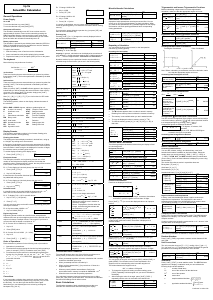


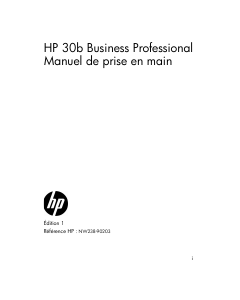
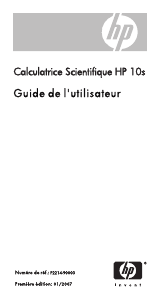
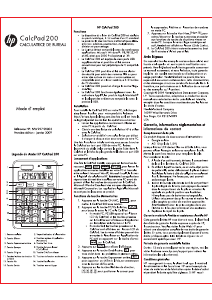

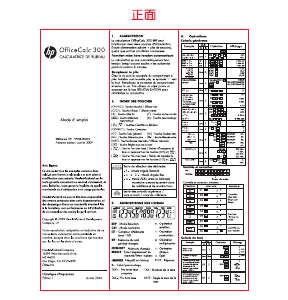
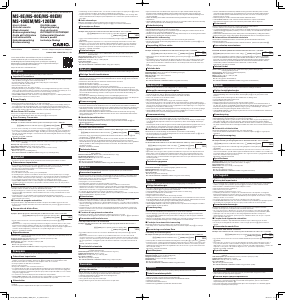
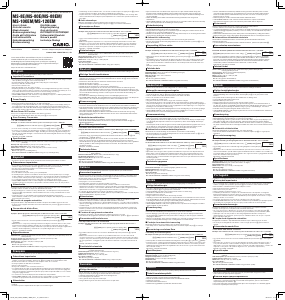
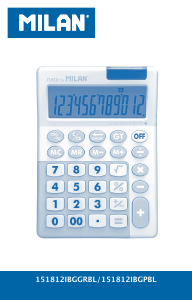
Joignez-vous à la conversation sur ce produit
Ici, vous pouvez partager ce que vous pensez du HP 9s Calculatrice. Si vous avez une question, lisez d’abord attentivement le mode d’emploi. La demande d’un mode d’emploi peut être effectuée en utilisant notre formulaire de contact.